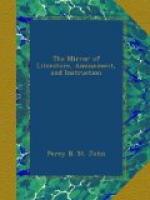The Fowlers appear to have been of some note. Sir Thomas Fowler, the elder, who died in 1624, was one of the jury on Sir Walter Raleigh’s trial: his son, Sir Thomas, was created a baronet in 1628; the title became extinct at his death. Some coats of arms were taken out of the windows of the old mansion. Among these were the arms of Fowler and Heron. Thomas Fowler, the first of the family who settled at Islington married the daughter of Herne, or Heron, of that place.[5]
[5] See Harl. MSS., No. 1551.
The Pied Bull, near Islington Church, is stated to have been the residence of Sir Walter Raleigh; though Oldys, in his Life of Raleigh, says there is no proof of it; and John Shirley, of Islington, another of Raleigh’s biographers, records nothing of his living there. The statement is, however, renewed in a Life of Sir Walter, published in 1740.
* * * * *
FINE ARTS.
* * * * *
THE PANORAMA OF MILAN.
By the aid of Mr. Burford’s panoramic pencil, the sight-hunter of our times may enjoy a kind of imaginary tour through the world. At one season he wafts us to the balmy climes of India—next he astounds us with the icy sublimities of the Pole (a fine summer panorama, by the way)—then to the glittering spires, minarets, and mosques of Constantinople—then to the infant world of New Holland—and back to the Old World, to enjoy scenes and sites which are hallowed in memory’s fond shrine, by their association with the most glorious names and events in our history. We remember the philosophical amusement of the great Lord Shaftesbury, in contriving all the world in an acre in his retreat at Reigate: what his Lordship laboured to represent in his garden, Mr. Burford essays in his panoramas—in short, he gives us all the world on an acre—of canvass.
Reader, we do not hold the grand secret of life to be the art of hoaxing, when we tell you that for a Greenwich fare you may be transported to the classic regions of Italy—that a walk to Leicester Square will probably delight you more than a ride to Greenwich, little as we are inclined to underrate the last of the pleasures of the people. The contrast is forcible, and the intellectual advantage to be enjoyed in the metropolis too evident to be overlooked.
At the Panorama, Florence is in the upper circle, and Milan in the lower one. The main attraction of the latter is the celebrated cathedral, which forms, as it were, the nucleus of the scene. The point of view has been objected to, as the spectator is placed about mid-way up the cathedral, and thus looks down into the streets and squares of the city; but, it should be remembered, that he also enjoys the distant country, which he could not have done had the view been from the area of the city; and, as we have before said, the beauty of the paysage is one of the perfections of Mr. Burford’s paintings. Its present success may be told from the Description:




